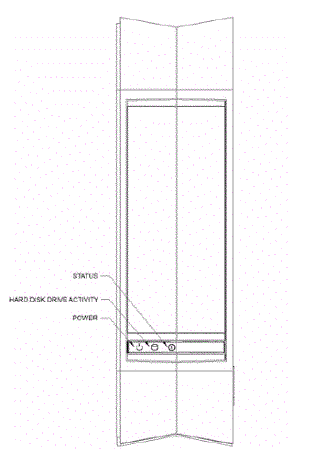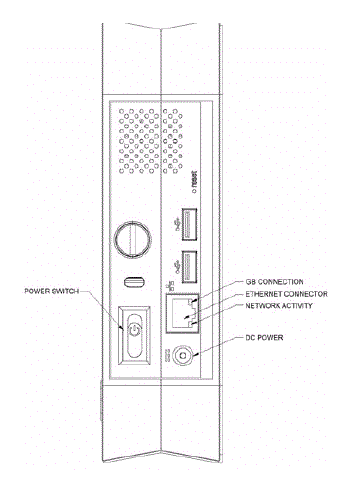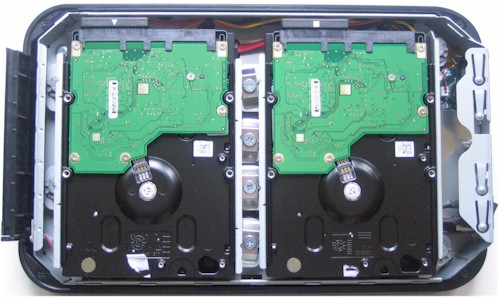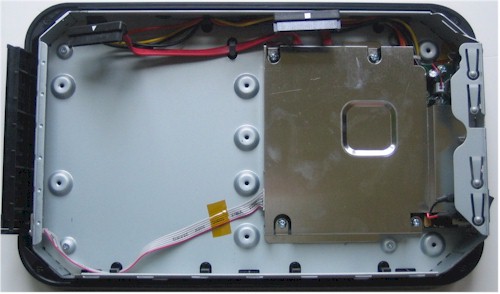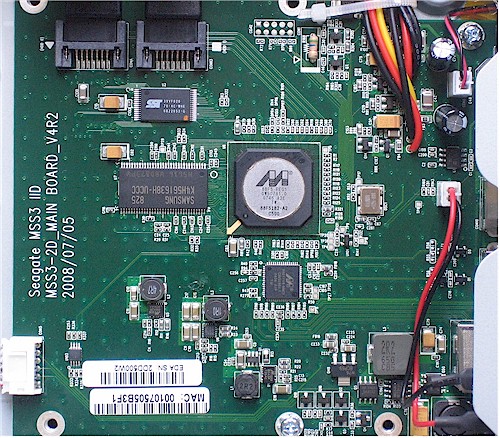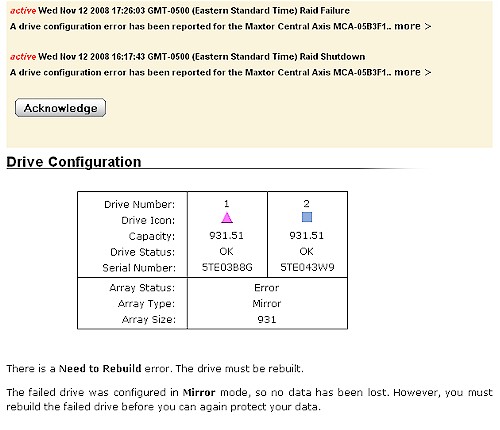Introduction
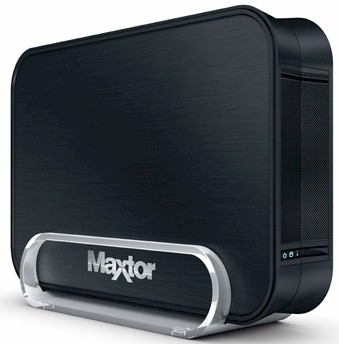
| At a Glance | |
|---|---|
| Product | Maxtor Central Axis Business Edition (STM320005CDA00G-RK) |
| Summary | Dual drive 2 TB NAS with gigabit Ethernet port, DLNA server and remote web access |
| Pros | • Remote web-based access • Built-in DLNA multimedia server, iTunes • USB support for external storage |
| Cons | • No AD or group support • Unhelpful logs • No FTP or NAS-to-NAS backup • Scary RAID 1 fail and recovery process |
Maxtor’s Central Axis Business Edition is a dual-drive follow-on product to the single-drive Central Axis [reviewed] introduced earlier this year. Aside from supporting two drive configuration modes—Linear (JBOD) and RAID 1—the Business Edition (CABE) is feature-for-feature identical to the original Central Axis.
Physically, the CABE retains the pyramid form factor of the original CA, but since it is stretched to accomodate two drives, it looks more rectangular. Figure 1 shows a diagram of the front panel, which contains only three status lights.
Figure 1: Front panel
Figure 2 shows the rear panel, which sports two USB 2.0 ports; one more than the CA.
Figure 2: Rear panel
Internal Info
Since the CABE is meant to be easily opened for drive replacement, I was able to get some good internal photos. Figure 3 shows the CABE with its cover removed and two Seagate Barracuda 7200.11 ST31000333AS 1TB drives in place.
Figure 3: Inside view
Figure 4 shows the drives removed, where you can see the board covered by a metal shield. Note the indendation in the shield, which I think is intended to contact the processor to provide some heat sinking.
Figure 4: Inside view, drives removed
Figure 5 shows the main board, with the Marvell Orion 88E5182 storage processor. Note that it doesn’t have a thermal pad to help thermal transfer to the indentation in the metal shield. Other components, which I suspect are shared with the CA are 64 MB of RAM (there is another Samsung K4H561638 32 MB chip on the other side of the board), 256 KB of flash and a Marvell 88E1118 gigabit Ethernet interface chip.
Figure 5: Main board
Like the CA, the CABE runs a modified version of FreeNAS and the drives are formatted with the UFS filesystem.
Power consumption is relatively low at 22W active and 14 W when drives are spun down. The single variable speed fan runs at very low speed, making the CABE virtually silent.
Features
As mentioned above, the only feature differences between the CA and CABE are the dual drives and RAID 1 support in the CABE. Otherwise they are feature-for-feature the same. So see the CA review if you would like more Feature details.
This means that the CABE lacks some features that are usually expected in a "business" NAS, most notably user Groups and support for joining an Active Directory or NT Domain for authentication.
While the CABE has emailed alerts, which are sent through a Seagate server, thus saving the hassle of entering your own SMTP server information, its log features are unhelpful. For example, when I changed the drive configuation from Linear to RAID 1, there was no entry in the log (and no email alert either).
Other "business features" commonly found on other "business" NASes, but missing from the CABE (and its bundled backup client software) are:
- HTTPS admin access
- Scheduled NAS-to-NAS backup
- FTP
- NFS and AFP support
- "Bare metal" backup
- Quotas
- Ability to suspend users
On the plus side, the web-based remote access feature is free and easy to set up and use and missing from many competitive products.
Changing drive modes is very simple as shown in Figure 6. I had previously changed from the default Mirror (RAID 1) configuration for testing.
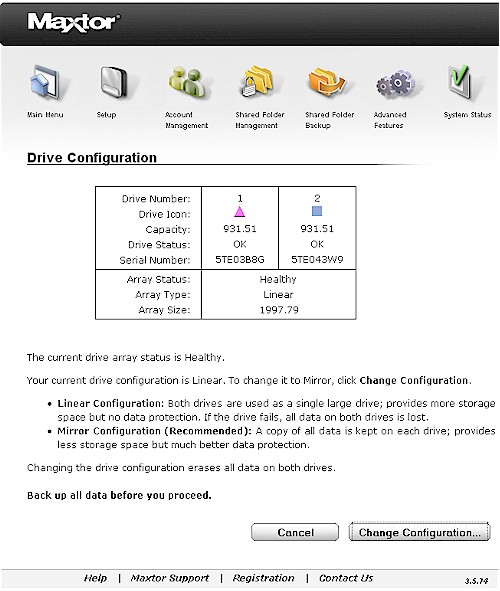
Figure 6: Drive configuration
Once you click Change Configuration, be prepared to wait awhile, however, since the whole process took around two hours. You get a nice status page that allows you to track the RAID 1 array creation and syncing. But if you change to another admin page , you won’t be able to get that page back and then have no way of tracking sync progress.
I should note that the normally slow response of the admin pages (typically 3 – 5 seconds to move from page to page) gets even slower during rebuild. I timed some pages as taking around 30 seconds to load!
Figure 7 shows the page during a RAID 1 rebuild after my pull-a-drive test (more shortly). I hadn’t yet cleared the error messages. Note that I am 17 minutes into the process and have just started the rebuild ("configuration" took the first 15 minutes).
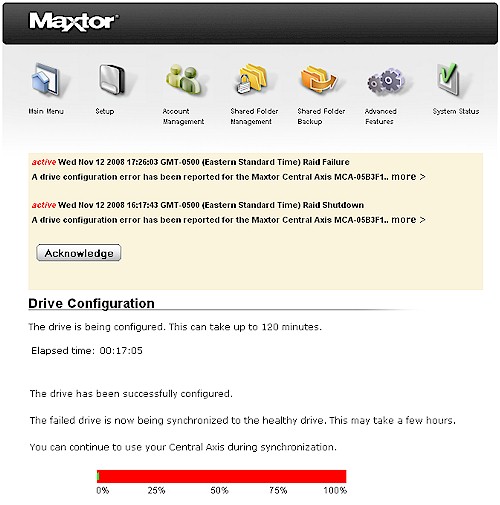
Figure 7: Rebuild status
Drive Fail Test
As we do with all RAID products, I performed a pull-a-drive test on the CABE, which was pretty squirrely. I configured the NAS in Mirror mode and waited for it to finish its sync. I then started a copy of a large folder to the NAS, waited for files to start moving, then disconnected the power/data connector from Drive 1 (marked with a triangle).
The file copy kept running, so I then refreshed the Drive Configuration page to check for a drive fail indication. But when I hit the page, I got an Apache (webserver) error (The requested URL /real_index.asp was not found on this server.) and shortly after, the filecopy stopped with Windows throwing an error.
As I was trying to figure out what to do next, the Status light on the front panel starting flashing a pattern of 1 white, 4 red, which the Admin User Guide told me was "Failure to mount shared folder partition". I then tried to shut down the CABE by momentarily pressing the power switch and then holding it down for at least 10 seconds. But neither worked, so I just pulled the power plug.
I then waited a few seconds and powered the CABE back up. After waiting for about a minute, I tried to access the admin page, but got a web browser timeout error. In the meantime, I could hear the CABE running its little fan at full speed and what sounded like a continuous cycle of reboots.
While I started to write up what was happening, however, the fan and reboot noise finally stopped after about 5 minutes. The Status light now was flashing one white, one red, which decodes to "Failure to mirror shared folder". I was finally able to access the admin page, which now displayed the error message shown in Figure 8 on each page. I also received an email alert informing me of a drive configuration error and that the CABE required attention.
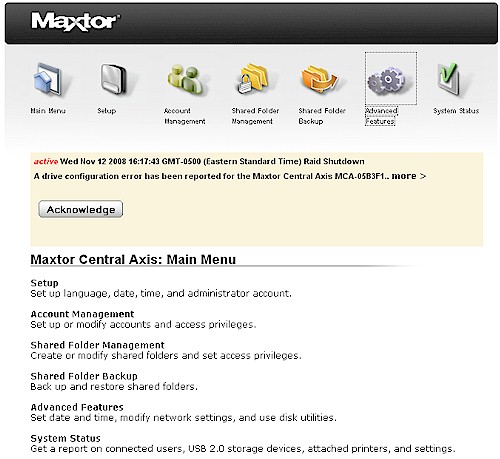
Figure 8: Drive error
As a final check, I opened My Network Places and browsed to the share and found that my copied data was intact and was able to restart the copy. So after a pretty scary 15 minutes or so, I found that in the end, everything was ok.
I then shut down the CABE, replugged Drive 1 and powered it back up. I now had two errors, both telling me the same thing. Clicking on the more > link brought me back to the Drive Configuration page (Figure 9), which now said I needed to rebuild (open the full-sized image to see the whole page with Rebuild button).
Figure 9: Drive rebuild screen
After confirming that my data was still there, I clicked the Rebuild button and got a confirmation screen, telling me that all data on Drive 1 would be erased and giving me the options to Cancel or continue with the rebuild.
I think it would lower the blood pressure anyone going through a rebuild process for the first time for this message to tell the user what "rebuild" means, i.e. that drive 1 would be erased and then have Drive 2 copied over to it! It would also be helpful if there were a Status light flash code that indicated "all is well, I’m just rebuilding" instead of the one white, one red "Failure to mirror shared folder" indication that you now get.
At any rate, after I clicked Continue, I checked to see if the share was available during rebuild, about 20 minutes or so into the process. Contrary to the information on the rebuild page, the share was not available, either by name or IP address until the rebuild completed. But when went back and looked again for the share about 10 minutes later (about 30 minutes into the rebuild), the share had magically reappeared!
Performance
IOzone was used to test the performance of the CABE (the full testing setup and methodology are described on this page). The test unit had the latest 3.5.74 firmware. It was tested with 100 Mbps, 1000 Mbps and 1000 Mbps with 4k jumbo LAN connections.
Like the Central Axis, the CABE’s NAS Chart rankings depend on the comparison group. Compared against all NASes, it ranks rather low. But if you compare it to dual-drive RAID 1 products, it moves up to the middle of the pack with RAID 1 writes using a 1000 Mbps LAN connection averaging 11.7 MB/s over 32 MB to 1 GB file sizes and 14.1 MB/s RAID 1 reads.
Figure 10 shows all the NAS Chart benchmark results, with some write tests plotted. Note that read performance is slightly faster than write and RAID 1 causes a slight performance hit. Jumbo frames also provide a bit of a performance boost.
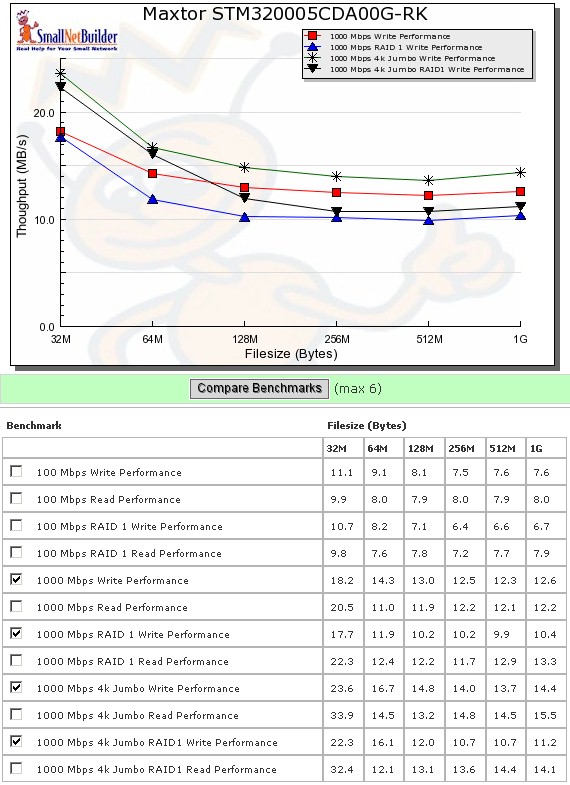
Figure 10: Write benchmark comparison
To see how the CABE ranked against competitive products, I chose three other diskful dual-drive products, the NETGEAR ReadyNAS Duo, Iomega ix2 and HP MediaVault Pro. The HP and Iomega both use the same Marvell 88E5182 "Orion" processor, while the NETGEAR uses Infrant’s IT3107 storage processor. The ReadyNAS Duo has the most memory at 256 MB, while the HP and Iomega have 128 MB.
Figure 11 shows the RAID 1 write performance of the HP, Iomega and CABE to be virtually identical.
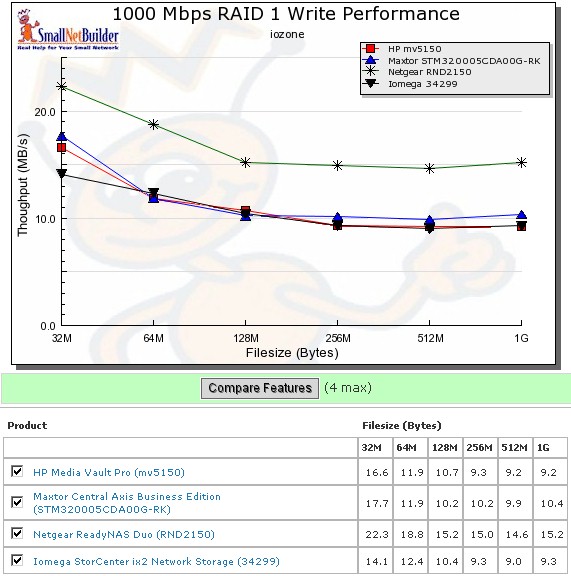
Figure 11: Competitive comparison – RAID 1 Write – 1000 Mbps LAN
RAID 1 read results (Figure 12) are a bit more dispersed and you can see a big drop in read speed on the NETGEAR once file size is equal to and greater then its 256 MB of RAM.
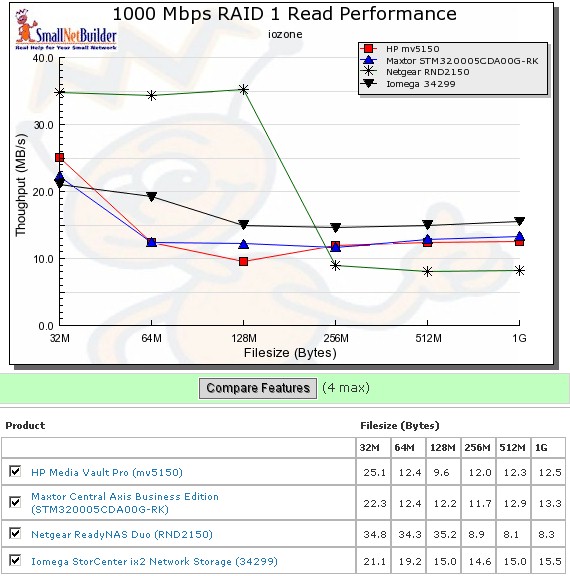
Figure 12: Competitive comparison – RAID 1 Read – 1000 Mbps LAN
In the end, the CABE’s performance looks pretty similar to other dual-drive products of similar hardware design.
Use the NAS Charts to run other comparisons.
Closing Thoughts
The only thing "business" about the Maxtor Central Axis Business Edition is its name and the data protection afforded by the addition of RAID 1. It’s really just a RAID 1 version of the Central Axis—a nice consumer NAS, but not particularly designed for “business” use.
But RAID is not a substitute for backup and I’d like to see Maxtor provide network and perhaps "cloud" backup options in addition to backup to an attached USB drive. Adding some of the missing business features that I touched on would probably help competitively, too. And finally, if this product is really targeted at businesses, it should not go offline when a drive fails and during rebuild. And the whole communication and logging process during failure and rebuild could be much improved.
On the plus side, pricing is in line with other multi-Terabyte diskful products (remember that the ReadyNAS Duo comes with only one drive when looking at prices) and the 5 year warranty will come in handy when one of the drives eventually fails. And the hassle-free (and free) remote file access feature will be particularly handy for travelers and even just the occasional retrieval of a file left back at work.
So if you can do without the missing features, are ok with mid-teen MB/s RAID 1 read/write speeds and can deal with a slightly scary RAID 1 fail and recovery process, then Maxtor’s Central Axis Business Edition might be the NAS for you.

